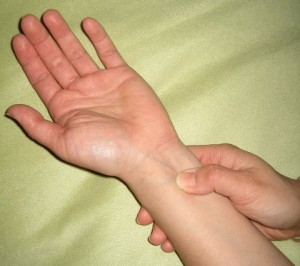Acupressure can be incredibly effective for nausea. I learned just how well it could work several years ago, when my son was playing competitive soccer. It was during the heat of the summer, and his team was in a weekend-long tournament. They had won a couple of games, and his team had advanced to the finals.
The night before their final game, Nate, one of their best and most strategic players (a forward) got the flu. When the team assembled the next morning, the players were hopeful that Nate would be there. A few minutes before game time, Nate’s family drove up to the field, and the players were elated–until the car door opened and they saw Nate, very pale and stretched out in the back seat. He was still really sick, and his stomach was still experiencing a serious reversal of fortune.
Nate’s parents knew that I was an acupuncturist, and asked if I had my needles with me. Um…no, I told them; I usually don’t roll with needles in my pocket. When they asked if there was anything I could do, I agreed to try some acupressure to see if I could get Nate on the field.
I applied pressure to a couple of points, but the main point I used was P6; the 6th point on the Pericardium pathway in Chinese medicine, found on the inside of the wrist. The pericardium is the protective tissue around your heart, so P6 is a great point for heart issues such as angina (heart pain) and palpitations. Also, because of it’s location on the palm side of your wrist, P6 is a good point if you’re suffering from carpal tunnel pain.
One of the most common uses for P6, however, is for nausea. That’s because the Pericardium pathway passes through your chest, down through your diaphragm and into your mid and lower abdomen. On it’s way, the pathway passes through your stomach, and when P6 on your wrist is stimulated, it can calm a funky stomach.
I have used P6 many times for effective relief from the flu, morning sickness (it’s safe to use during pregnancy!) and for nausea caused by chemotherapy. It also works for motion sickness, and is the theory behind those sea sickness wrist bands. The bands work because they have a little bead or magnet that rests right on the P6 point.
 Here’s how you can locate P6 yourself: In general, the point is found about two inches above your wrist crease on the palm side, right in the middle, in between the tendons.
Here’s how you can locate P6 yourself: In general, the point is found about two inches above your wrist crease on the palm side, right in the middle, in between the tendons.
More specifically, in Chinese medicine, the distance between your wrist crease and elbow crease is twelve units, called cun (pronounced soon). P6 is located two cun above your palm side wrist crease. The easiest way to find it is to divide the distance between your wrist and elbow in half; six cun each. Then divide the lower half into thirds, and the first third closest to your wrist is the location of P6. Now poke around in between the tendons until you find a spot that is a little tender, and voila! you’ve found the point. Once you’ve located P6, stimulate where it’s tender by pressing with your thumb or index finger for a minute or two on each side.
The P6 point worked well for Nate. After working on him for about ten minutes, he started to perk up. His stomach calmed down considerably, and the color returned to his face. He was able to peel himself off the back seat of the car and walk down to the soccer field. Unfortunately, he was still pretty weak from the flu and was unable to play. Their team lost the game, came in second in the tournament, and a day later couldn’t remember whether they had won or lost.




PC6 is a superb point to use and as an emergency point brilliant. Another great point to use in those type of cases is Ren 12, being the Mu point of the stomach. I have found that is also very effective in helping chronic or acute gastric problems.
I am a acupressure therapist in Mumbai and was looking for information of Nausea.
Thanks for the Post.
I’m having a very nauseaus pregnancy and this works amazingly! 🙂 Thanks so much!